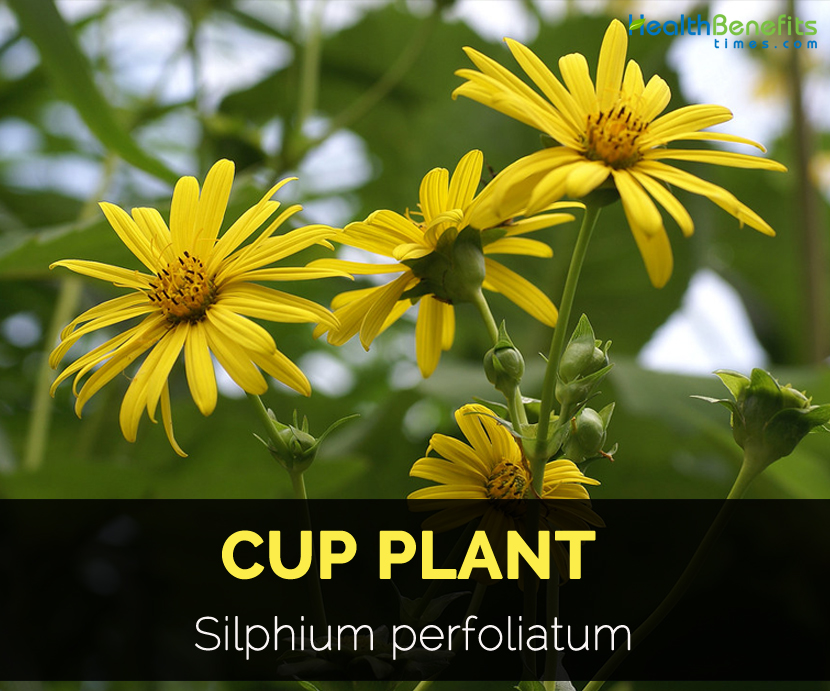
Stems are stout, smooth, and erect, four sided and branched near the top. The sap is resinous with a milky latex. The sap hardens after the flower heads are removed.
Leaves
Leaves are simple and opposite. Upper leaves surround the stem and unite at the bases in order to form a cup. Lower leaves have winged petioles. Each leaf is rough and covered with dots and measures about 6-14 inches long and about 4-8 inches wide. They are ovate, cordate, deltoid and triangular. They have wavy and coarsely toothed margins and a prominent midrib.
Facts About Cup plant
| Name | Cup Plant |
|---|---|
| Scientific Name | Silphium perfoliatum |
| Native | Native to eastern and central North America |
| Common/English Name | Indian Cup Plant, Indian Gum, Ragged Cup, Rosinweed, Ragged Cup, Cup-plant, Cup rosinweed, Carpenter’s weed, Compass plant, Squareweed, Pilot weed, Indian cup |
| Name in Other Languages | German: Becherpflanze, Durchwachsene Silphie, Becherpflanze, Verwachsenblättrige Becherpflanze; English: Indian cup-plant, Indian-gum, Cup plant, Cup-plant, Cupleaf rosinweed, Squarestem rosinweed, Cup rosinweed; |
| Plant Growth Habit | Erect herbaceous perennial |
| Plant Size | 1–2.5 m (3–8 ft) |
| Stem | Stout, smooth, slightly hairy |
| Leaf | Opposite, toothed, ovate, 30 cm in length and 20 cm in width |
| Medicinal parts | The root |
| Flowering Season | Midsummer to autumn (fall) |
| Flower | Yellow, 6-8 cm wide |
| Seed shape and size | Achene, 9-15 mm, a width of 6-9 mm, strongly flattened |
| Seed color | Brown |
| Seed weight | 23 g |
Flowers
Flower heads are arranged in open, branched, termainal and cymed clusters. Flower heads are yellow and measures about 1¾-4 inches wide. Flowers have numerous sterile, tubular, dark yellow, radially symmetrical about ½ -1 inch wide disk flowers. The plant blooms flower from July to October. Flowers are pollinated by insects
Fruit
Flowers give way to slender, oblong, ovate, brown and single seeded achene or capsule with hard shell, two teeth, and thin or marginal wing. Achenes are dispersed by wind.
Uses
A strong infusion of the root, made by long steeping, or an extract is said to be among the best remedies for the removal of ague cake, or enlarged spleen. As nearly as can be ascertained the spleen, liver and stomach are dependent on each other and the derangement of either or all is closely associated. Also useful in intermittent and remittent fevers, internal bruises, debility, ulcers, liver affections and as a general alterative, restorative. The gum is said to be a stimulant and antispasmodic.
Dose
1 teaspoonful of the root, cut small or granulated, to 1 cupful of boiling water. Drink 1 cupful during the day, a large mouthful at a time. Of the tincture, 5–20 drops.
Medicinal uses
- Root decoction is used for regulating periods, treat morning sickness and prevent premature child birth.
- Root is antispasmodic, alterative, emenagogue, diaphoretic, febrifuge, emenagogue, stimulant, hepatic, tonic and styptic.
- It is used for treating liver and spleen disorders.
- Use the root decoction internally for treating back pain, chest pain and lung hemorrhages.
- Apply the moistened dried root to wounds to halt bleeding.
- Use it as a chewing gum for preventing nausea and vomiting.
- Root decoction is used as a face wash.
- Resin is used in chewing gum to freshen breath.
Culinary uses
- Inhale the smoking roots and use it for treating neuralgia, head colds, stomach ailments, rheumatism and vapor baths.
- Root tea was used for enlarged spleens, fevers, lung bleeding, internal bruises, general debility, ulcers, liver ailments and female problems.
- An ointment ad extract is used to heal burns.
- Chew the dried resinous sap as gum and used for freshening breath, cleaning or whitening teeth and also to prevent vomiting.
- Young leaves are cooked and consumed as potherbs.
References:
https://en.wikipedia.org/wiki/Silphium_perfoliatum
https://indiananativeplants.org/images/resources/Gordon%20Mitchell%20Articles/GM_cup_plant.pdf
http://www.naturalmedicinalherbs.net/herbs/s/silphium-perfoliatum=cup-plant.php
Comments
comments